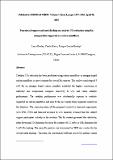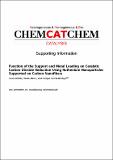Por favor, use este identificador para citar o enlazar a este item:
http://hdl.handle.net/10261/198866COMPARTIR / EXPORTAR:
 SHARE SHARE
 CORE
BASE CORE
BASE
|
|
| Visualizar otros formatos: MARC | Dublin Core | RDF | ORE | MODS | METS | DIDL | DATACITE | |

| Título: | Function of the support and metal loading on catalytic carbon dioxide reduction using ruthenium nanoparticles supported on carbon nanofibers |
Autor: | Roldán, Laura CSIC; Marco, Yanila CSIC; García-Bordejé, José Enrique CSIC ORCID | Palabras clave: | Hydrogenation Doping Nanoparticles Reaction mechanisms Ruthenium |
Fecha de publicación: | 9-abr-2015 | Editor: | Wiley-VCH | Citación: | ChemCatChem 7(8): 1347-1356 (2015) | Resumen: | Catalytic CO2 reduction has been performed using carbon nanofibers or nitrogen‐doped carbon nanofibers as a support for Ru nanoparticles. The catalyst that consists of 5 wt % Ru on nitrogen‐doped carbon nanofibers exhibited the highest conversion at a relatively low temperature, complete selectivity to CH4, and stable catalytic performance. The catalytic performance was substantially superior to catalysts supported on carbon nanotubes and akin to the best metal‐oxide‐supported catalyst in the literature. The characterization of the prepared catalyst by transient experiments (CO2 temperature‐programmed desorption, temperature‐programmed surface reaction, and transient response to CO2 removal) revealed that the catalyst support participates actively in the reaction. The Ru content governed the selectivity, which either favored CO formation for lower Ru contents (0.5–2 wt %) or CH4 formation for 5 wt % Ru loading. The mean Ru particle size determined by TEM was similar for each of the metal loadings. Therefore, the substantially different selectivity patterns cannot be attributed to structure sensitivity. The higher selectivity to CH4 can be explained by the enhanced supply of adsorbed hydrogen to the activated adsorbed CO intermediate, which was demonstrated to be the rate‐determining step. | Descripción: | 8 Figuras, 3 Tablas.-- Información suplementaria disponible en línea en la página web del editor. | Versión del editor: | http://dx.doi.org/10.1002/cctc.201500016 | URI: | http://hdl.handle.net/10261/198866 | DOI: | 10.1002/cctc.201500016 | ISSN: | 1867-3880 | E-ISSN: | 1867-3899 | Referencias: | Bustinza, Ainhoa; Roldán, Laura; García-Bordejé, Enrique. CO2 reduction to CH4 using Ru on carbon nanostructures and on alumina coated monoliths. http://hdl.handle.net/10261/198854 Roldán, Laura; Marco, Yanila; García-Bordejé, José Enrique. Origin of the excellent performance of Ru on nitrogen-doped carbon nanofibers for CO2 hydrogenation to CH4. http://dx.doi.org/10.1002/cssc.201601217. http://hdl.handle.net/10261/149000 |
| Aparece en las colecciones: | (ICB) Artículos |
Ficheros en este ítem:
| Fichero | Descripción | Tamaño | Formato | |
|---|---|---|---|---|
| ChemCatChem v7_8_1347-1356_2015.pdf | Artículo principal | 1,29 MB | Adobe PDF |  Visualizar/Abrir |
| ChemCatChem 7(8)1347(2015) info sup.pdf | Información suplementaria | 373,25 kB | Adobe PDF |  Visualizar/Abrir |
CORE Recommender
SCOPUSTM
Citations
23
checked on 25-mar-2024
WEB OF SCIENCETM
Citations
21
checked on 06-feb-2024
Page view(s)
231
checked on 18-abr-2024
Download(s)
285
checked on 18-abr-2024
Google ScholarTM
Check
Altmetric
Altmetric
NOTA: Los ítems de Digital.CSIC están protegidos por copyright, con todos los derechos reservados, a menos que se indique lo contrario.
